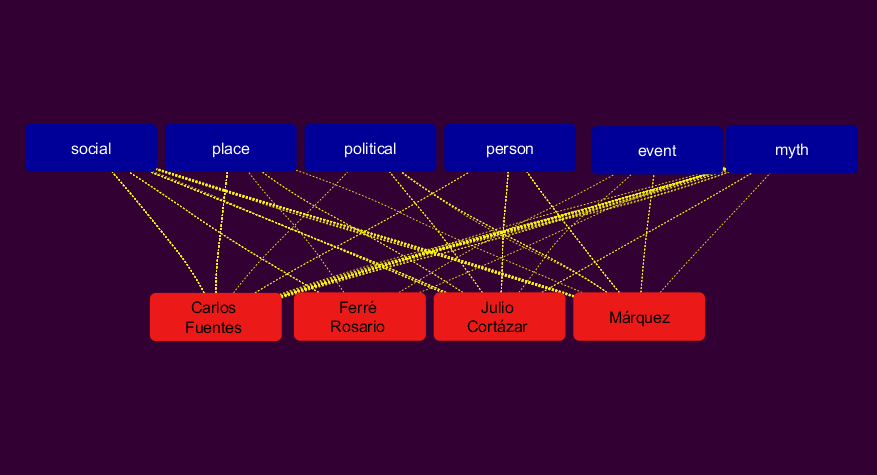Data Visualizations

One way to visualize our data that we deemed useful was to show the usage of allusions by each of our authors. We represented this data using the Cytoscape software, a free, open source graphing tool often used for mapping biological data. We ran an XSLT transformation of every allusion and its type and value per author of our texts; notably, Juan Rulfo did not use any allusions in "No Oyes" and does not appear in this graph. The red nodes on the bottom of the graph represent each author, while the blue nodes on the top represent each type of allusion used by the authors (a reference: myth, place, person, event, or a critique: social or political). The yellow lines connecting them are the number of allusions used by each author.
By far, the pattern that stands out the most is the number of mythological references used by Carlos Fuentes in the story "Chac Mool". So many lines (37) connect these two nodes that we had trouble fitting the the visualization on the screen in our initial renderings of the graph. Many of these mythical allusions are references to the term "Chac Mool" itself, which depending on the viewing can be an unfavorable skew of the data. There are also notable connections in the number of social allusions used by all four authorso, and how few political references were used in the stories we analyzed. The mythical allusions were sparsely used by all authors other than Fuentes, and Fuentes used each type of allusion at least once in "Chac Mool" except for a 'social' reference.
Use of Preterite and Imperfect in Magic Realist Texts
The Preterite Tense and the Imperfect Tense are two forms of the past tense that are used by the Spanish language, and they are expressed through the conjugation of verbs. The Preterite Tense is used to signify a completed action, a single (completed) events, actions that are a part of a set of actions, and actions that can be quantified. Generally, the Preterite Tense is used to describe events that have a specified start and end. The Imperfect Tense on the other hand, is used to describe more permanent events in the past tense, such as characteristics, physical (or mental) states of being, actions that were repeated habitually, and actions that occur as the backdrop for more finite actions. In sumnation, actions in the imperfect tense do not have a clearly specified end.
This bar chart shows the percentages of preterite versus imperfect tense used in each of our magic realism texts. One interesting feature of the data is that although there is no clear pattern that can conclusively state that one tense is used more than the other, the imperfect tense appears more than preterite in four of our texts while preterite appears more in only three. Additionally, when preterite appears more than the imperfect, there is only a slight difference in the percentages that each are used. When the imperfect appears more than the preterite, the difference between the percentages is much greater.
To create this chart, we used SVG in XSLT, and analyzed previously tagged occurences of the preterite tense and imperfect tense in each of the stories' XML files. We then used XPath functions in our SVG to calculate the percentages, and created bar charts that display the data.
Percentage of Time Spent in Reality
This graph measures the time spent in reality vs. surreality in our examined magic realist stories. Although it’s a somewhat crude measure, literally only counting the amount of characters in each real and surreal section then comparing them with each other, the graph acts as a useful measure to see how these authors balance reality with the unreal in their stories. As one can see, Rosario Ferré’s “La muñeca menor” spends the entirety of its time in reality, while Juan Rulfo’s “No oyes ladrar a los perros” is entirely surreal (perhaps explaining or at least relating to its total lack of references). Julio Cortázar spends roughly equal time in reality and surreality with the stories “Casa tomada” and “La noche boca arriba,” most closely adhering to the concept that magic realism is a blend of reality and fantasy.